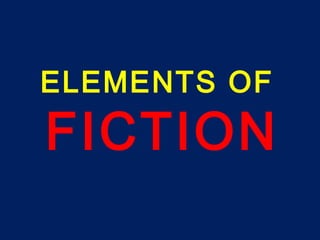
Elements of fiction
- 2. Elements of fiction: I.PLOT II.SETTING III.CHARACTRS IV.POINT OF VIEW V.THEME
- 3. I. PLOT Plot is the author’s arrangement of events in the story. It has a beginning, middle and an end. More specifically, the plot follows the Freytag pyramid:
- 4. Narrative Stages The narrative stages or stages of the plot are as follows: • Exposition: The start of the story, the situation before the action starts • Rising Action: The series of conflicts and crisis in the story that lead to the climax • Climax / Turning Point: The most intense moment – either mentally or in action – the reader wonders what will happen next; will the conflict be resolved or not? • Falling Action: The events and complications begin to resolve themselves. (The events between the climax and the resolution) • Denouement (Resolution): The conclusion, the untangling of events in the story
- 5. Types of Plot Events in a story can be presented in a variety of orders: • The chronological order: some stories begin with what happens first, following the regular time development of events to end. • Some stories begin at the end then lead up to why and how things developed as they did. • Some stories begin in the middle of things.
- 6. Flashback This is a technique in which the author interrupts the plot of the story to tell an incident of an earlier time (goes back in time; like giving the reader a memory).
- 7. Foreshadowing This is a writers’ technique in which the author provides clues or hints as to what is going to happen later in the story.
- 8. Conflict Conflict is the struggle between two forces in a story. The plot revolves around this conflict.
- 9. Types of Conflict • Physical Conflict: Between a character and nature or the physical world. • Social Conflict: Between characters or between the character and his or her society. • Internal Conflict (Psychological Conflict): Between different attitudes of beliefs in the character’s mind.
- 10. II. SETTING The setting is the place and time of the story. It also includes the circumstances of the story, like the weather conditions, the social class, etc.
- 11. III. CHARACTERS The people (or animals, things, etc. presented as people) in a literary work.
- 12. TYPES OF CHARACTERS Characters can be classified in different ways: • Major and minor characters • Round and Flat characters • Dynamic and Static characters • Protagonist and Antagonist
- 13. ROUND AND FLAT CHARACTERS • Round Characters are complex convincing, and true to life characters. They are described in more detail, having many different and sometimes even contradictory personality traits. • Flat Characters are stereotyped, shallow, and often symbolic. They have only one or two personality traits
- 14. DYNAMIC AND STATIC CHARACTERS: • Dynamic Characters undergo some type of change or development in the story, often because of something that happens to them. • Static Characters do not change in the course of the story.
- 16. Characterization Characterization refers to the methods used by the writer to create his or her characters.
- 17. METHODS OF CHARACTERIZATION: Characters are revealed to us by means of the following techniques or some of them. • Physical appearance • Names • What the narrator tells us about them • What other characters say about them
- 18. IV. POINT OF VIEW The angle or perspective from which the story is told (Who tells the story) • The point of view is divided into two main types: - First person point of view - Third person point of view
- 19. First Person Point of View The story is told from the viewpoint of one of the characters, using the first person pronoun “I”. The first person narrator can either be participant or nonparticipant in the action
- 20. Third Person Point of View The story is told using a narrator who uses third person pronouns such as “he”, “she”, “his”, “her”, “they” etc. Third Person Point of View can be broken up into three different types: • Omniscient • Limited Omniscient • Objective
- 21. Omniscient Point of View: The narrator has the power to show the reader what is happening in the minds of the characters, their feelings and their thinking. Limited Omniscient Point of View: The narrator shows us inside the mind of one character. Objective Point of view: The story is told as if from a camera that follows the characters. Only what is said and done is recorded.
- 22. V. THEME Theme is the central idea or central message of the story. It usually contains some insight into the human condition – telling something about humans and life.
- 23. OTHER TECHNIQUES IRONY • Verbal Irony:: This is the contrast between what is said and what is meant. • Dramatic Irony: This is the contrast between what the character thinks to be true and what we (the readers) know to be true. Sometimes as we read we are placed in the position of knowing more than what one character knows. Because we know something the character does not, we read to discover how the character will react when he or she learns the truth of the situation. • Situational Irony: It is the contrast between what happens and what was expected to happen.
- 24. SYMBOLISM A symbol represents an idea, quality, or concept larger than itself. A journey can symbolize life Water may represent cleanliness and renewal A lion can be a symbol of courage. A red rose can represent love.